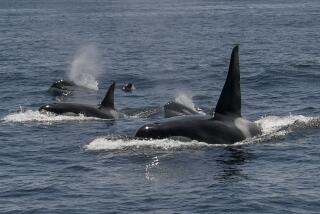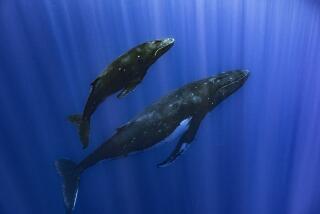If it quacks like a bio-duck, it’s a minke whale, scientists say
The mysterious “bio-duck” sounds in the ocean that have baffled seafarers for decades are actually calls from unseen populations of minke whales, scientists say. The discovery detailed in the journal Biology Letters will allow researchers to better track these animals even when they’re out of sight.
“Our results solve the mystery around the source of the bio-duck sound, which is one of the most prevalent sounds in the Southern Ocean during austral winter and can now be attributed unequivocally to the Antarctic minke whale,” the study authors wrote.
The bio-duck was first heard in the 1960s by submarine personnel and subsequently recorded all over the Southern Ocean. At first, it was thought to be made by other submarines, or unknown oceanographic phenomena, or even fish. The sound consisted of a series of low-frequency pulses between 50 to 300 hertz, with harmonies up to 1000 hertz, with 3.1 seconds between the series.
To add to the puzzle, the strange sound also was picked up at the same time in very distant locations, like the eastern Weddell Sea and off the coast of Western Australia. If it was an animal, this could either mean that the animal was very widespread or that part of the population was migrating while the other part was staying behind.
Scientists led by Denise Risch of NOAA’s Northeast Fisheries Science Center solved this mystery by tagging two minke whales in Wilhelmina Bay along the Antarctic Peninsula with suction-cupped recording devices to tape the whales’ calls. Sure enough, the whales did start to make these strange calls, which matched up with previously recorded bio-duck series, down to the 3.1 gap between each series of calls.
The findings are a boon for scientists, who can now track the whales using these sounds and even go through the backlog of calls recorded from previous years to pick up on long-term patterns in migration and behavior. It’s a very cheap and effective way to study them, compared with scientists’ other options.
“Antarctic minke whales live in remote open-water environments and within sea ice habitats,” the authors point out. “Traditional ship-based study methods are extremely expensive, and data from such studies are complex and difficult to interpret.”
Studying the whales’ call history could provide researchers with a detailed look into the distinctions between different populations. For example, whales living in separate areas seem to have different call patterns. Those off of East Antarctica will send out three pulses in each call series. But those in West Antarctica put out five to six pulses in each series.
“The identification of the Antarctic minke whale as the source of the bio-duck sound will allow a more detailed understanding of the behavioural ecology of this abundant, but poorly understood species,” the study authors wrote. Here’s a sample of what a bio-duck call sounds like.
ALSO:
‘Wonder material’: Scientists produce graphene in kitchen blender
Meet Kepler-186f, the most ‘Earth-like’ planet ever found
Fruit flies make blazing fast turns like fighter jets
A hunt for dark matter in a former gold mine







